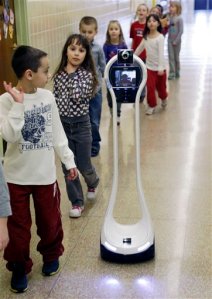 So is Apple developing a watch?
So is Apple developing a watch?
Honestly? Who knows? I have no doubt that Apple (AAPL) has thought about a watch. And I have little doubt that they have even played around with the concept and put some people on it as an exploratory project. Now, according to my Bloomberg News colleagues Peter Burrows and Adam Satariano, Apple has put about 100 people on the project, which would indicate something more serious than a lark. But Apple is not afraid to pull the plug on things, so the future of this product still remains speculative.
Do you want to speculate, then?
Sure! I mean, I can understand the idea behind an iWatch. In some ways, I can understand it more readily than I can Google’s Project Glass. While getting an augmented-reality view of the world would be totally cool in that T-800 kind of way, it still requires you to wear glasses. Now, I like wearing glasses, but not everyone may feel the same—witness the sluggish adoption of 3D TV, which also requires eyewear. A watch, on the other hand, is discreet. Anyone can wear a watch.
Do you wear a watch?
Of course not. I carry my iPhone with me everywhere.
What do you think a watch from Apple would do? More speculation, please.
Well, I think the first thing it would do is work in tandem with an iPhone. An iWatch (let’s just call it that for now), would need to have great battery life, so making it a self-contained computing device doesn’t make sense. It would consume too much power. But as something that has a display and some basic inputs and connects wirelessly via Bluetooth to the phone—where the real heavy lifting takes place? That could make the watch a more power-efficient accessory to the iPhone.
Would it have a display?
I think it would have to. Given the low-power characteristics of technologies such as AMOLED (that’s Active-Matrix Organic Light Emitting Diode, for those playing along at home) you could create a wrist-sized touchscreen. If you forsook touch—and I don’t think Apple would—you could go the E-Paper route (thinkAmazon (AMZN) Kindle), which uses even less power. This is the approach taken by Pebble, an independent maker of a Bluetooth-enabled watch that links to your smartphone and displays relevant information.
But would I be able to make phone calls on it, like Dick—
I’m gonna cut you off right there, if you don’t mind. I’ve placed a moratorium on references to a certain yellow-trenchcoated detective when it comes to wrist-borne communications devices. That being said, I don’t necessarily think that the iWatch needs—or even should have—phone capabilities. In this fantasy world I have created, the iWatch works only in concert with an iPhone. Your phone is a good device for making calls—one end is up by your ear, the other is down by your mouth. There are even headphones with built-in mics for hands-free calling. Why would you talk into your wrist?
So what does it do, if it doesn’t make calls?
It could do a lot of things. With a display, the iWatch could easily remind you of upcoming appointments or to-do items by tone or vibration. Incoming texts, e-mails, and other messages could be read from your wrist. Turn-by-turn navigation cues could also be displayed: Imagine you come out of a subway staircase onto the street, and you hold up your wrist to see an arrow pointing left, saying “three blocks.”
While I don’t think an iWatch would work as a phone, I could see it working with Siri. Holding your wrist up to tell Siri to schedule lunch with your friend for tomorrow at 1 makes a lot more sense than holding an entire phone conversation on your watch.
The iWatch could also be a real competitor to wearable fitness devices, such as Jawbone’s Up, Nike’s (NKE)FuelBand, and Fitbit’s Flex. All those devices currently work with the iPhone to collect and analyze data. What if Apple were to develop its own service? After all, Tim Cook, Apple’s chief executive officer, is a noted fitness fanatic.
Isn’t Tim Cook on Nike’s board of directors?
He sure is, which would make things a little awkward if Apple came out with a device that directly competes with something Nike makes.

 By
By 